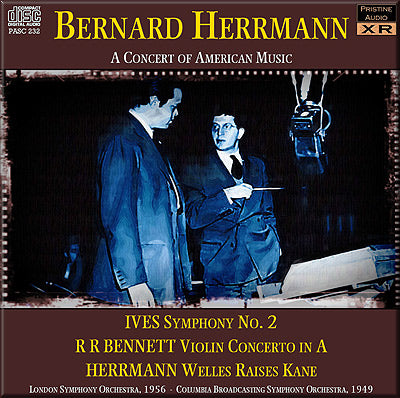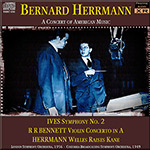
This album is included in the following sets:
This set contains the following albums:
- Producer's Note
- Full Track Listing
- Cover Art
- Bernard Herrmann
Fascinating and brilliant - Herrmann conducts American Music
Three excellent radio recordings newly transferred and remastered
This collection of radio broadcast recordings, brought together as a kind of concert-on-CD, if you like, brings together several aspects of the work of Bernard Herrmann, a composer and conductor who still commands a committed following today, some 35 years after his death.
Having grown up in New York City, schooling first in Brooklyn, later at New York University and Jullliard, it seems only appropriate that this most American of musicians should introduce the British public to the Second Symphony of Charles Ives. Remarkably, it's a work which, somewhat like its composer, was rejected for half a century – Ives began work on it in 1897 and completed it in the first years of the new century, but had to wait until 1951 for its rapturously-received première under the baton of Leonard Bernstein. Five years later it was Herrmann, conducting the London Symphony Orchestra for a studio broadcast concert, who premièred the work in the UK.
The copy here was taken from an open-reel tape from what would appear to be a rebroadcast or disc transcription from the occasional clicks I had to deal with. The FM-quality broadcast sound quality is more than acceptable if prone to occasional peak distortion and a little tape flutter-dropout at the very beginning, the performance a credit both to orchestra and conductor.
Our second work is the Violin Concerto in A by Robert Russell Bennett, and presents another interesting connection. Bennett straddled the worlds of classical music and Broadway musicals in a similar manner to Herrmann and his film music; in both cases the 'other' work has remained longer in the memories of music lovers than what some might consider the composers' more “serious” output, but that should not distract from this most fascinating and delightful piece.
The soloist here the concerto's dedicatee and Bennett's friend, the violinist Louis Kaufmann. It's a very accessible piece (subtitled “in the popular style”) and would surely stand reviving, and includes an astonishing if very short virtuoso display in the third movement.
An alternative release of this piece on CD is currently available – but the sound quality on it is particularly grim and the piece about a semitone out of tune! This new transfer came from a mid-70s 'pirate' LP release which found its way into Edward Johnson's collection. I've endeavoured to remove the unfortunate fake stereo effect applied to the LP release – on which I also noted a bizarre and unpleasant change in equalisation for the finale which amplified mid-range frequencies to the great detriment of the listener; this, too, has been ameliorated. Overall sound is generally very good, perhaps a slight improvement on the Ives thanks to clearer top-end extension, though there is still a slight tendency to peak distortion in some sections, which I've tried to control as much as possible.
The finale of this Concert of American Music is an orchestral suite of Herrmann's own music. Entitled "Welles Raises Kane", its five movements are drawn from the film scores Herrmann wrote for Orson Welles' first two feature films, his early-1940s screen masterpieces Citizen Kane and The Magnificent Ambersons, both regarded by critics as among the two best American films ever made.
As with the Bennett, this is the only recording of this piece I've been able to trace (though I'm reliably informed it was recorded again by Hermann in 1967 and issued on CD in 1994), and as with the Bennett it has also been issued elsewhere, in poorer sound, and again badly pitched. The Bennett was relatively straightforward to check for pitching – we know from the title that the piece is in A, and there are a number of obvious A's at the beginning of the first movement which lend themselves to frequency analysis. The Herrmann was slightly harder to judge – again the alternative release I found was a good semitone out of tune by comparison to the present recording. Without a score, a modern reference or a named key it took a little more ingenuity to check pitching here – I obtained a copy of the film Citizen Kane, extracted from it the audio soundtrack, and scanned through this until I found the music which Herrmann used for his Overture. It was immediately clear to the ear that this was both in the same key as the present performance and in tune. I rest my case!
Sonically this 1949 radio broadcast is a little more constricted than the previous two recordings, though in still very clean and listenable AM broadcast sound. It was originally recorded onto 78rpm acetates, and I've endeavoured to iron out the clear differences in surface noise between the sides to allow a greater continuity of sound. As with the other recordings, I've retained all the broadcast announcements available to me.
Andrew Rose
IVES Symphony No. 2 (1897-1901) (UK Première)
London Symphony Orchestra
conducted by Bernard Herrmann
BBC Studio Broadcast of 25 April, 1956
ROBERT RUSSELL BENNETT Violin Concerto in A (in the Popular Style) (1941)
(UK Broadcast Première) [notes]
Louis Kaufman, violin
London Symphony Orchestra
conducted by Bernard Herrmann
BBC Studio Recording of 20 May, 1956
HERRMANN Welles Raises Kane (1943)
(Orchestral suite from his music for 'Citizen Kane' & 'The Magnificent Ambersons')
Columbia Broadcasting Symphony Orchestra
conducted by Bernard Herrmann
CBS Radio Broadcast of 3 July, 1949
Transfers by Andrew Rose from Edward Johnson's private collection
XR remastering by Andrew Rose at Pristine Audio, June 2010
Cover artwork based on a photograph of Orson Welles and Bernard Herrmann (Citizen Kane, 1941)
Total duration: 76:44
|
|
|
|
|
|
Fanfare Review
This disc should not be missed by anyone who values the Second Symphony—which should mean all of us
In 1909, Ives had a full ink copy of his Second Symphony made; in 1911, he loaned it to conductor Walter Damrosch (1862–1950). Ives twice asked Damrosch for it back, in 1915 and 1935, with no success. Footnote 54 on p. 471 of Jan Swafford’s Charles Ives: A Life with Music: “Ives’s own pre-final drafts of the Second and Third Symphonies survive, which are the versions currently used. Bernard Herrmann told Vivian Perlis he had found the final score of the Second in Damrosch’s papers, but if so he lost it again.”
Herrmann (1911–75) had been a major Ives supporter since 1932, conducting his own arrangement of the fugue from Ives’s Fourth Symphony in 1933 and several times thereafter. It seems improbable, incredible, that he could have “lost” so important, so triumphant a find. By the time of Herrmann’s death, Ives was the center of attention of a raft of American musicologists, and such a score could not have gone unnoticed. In the end, one is forced to question Herrmann’s claim of finding the score—as does Swafford, judging from the sarcastic tone of his footnote. Did Herrmann still have that score in 1956, and did he use it for this BBC radio recording? Oddly enough, I have not seen that question addressed in the Ives literature; perhaps no one believed Herrmann’s story. Although we cannot know what differences existed in the 1909 score, this performance suggests not: It sounds too familiar; yet the wildly dissonant, 11-tone final chord—added by Ives many decades later—is suspiciously consonant here.
Herrmann certainly understood Ives; this performance, although orchestrally a bit vague and occasionally sloppy, fully captures the composer’s nostalgia for the Danbury of his youth. Some of the phrasing is a bit square—the excellent London Symphony was dealing with an unfamiliar score—but a surprising amount of it is right on. What it lacks is the vitality and sparkle of Bernstein’s 1951 radio premiere and of his excellent 1958 stereo recording (Columbia, now Sony) with the New York Philharmonic, which by then had played the symphony 13 times and so knew it well. Herrmann does attack the finale with gusto, but orchestral struggles and a blowsy monaural recording deny us much detail. Still, this CD is a big improvement on the original LP, as Andrew Rose has done his usual superb transfer and production.
For four decades, Robert Russell Bennett (1894–1981) was the leading orchestrator of Broadway musicals—300 of them, from Rose Marie and Show Boat to My Fair Lady and Camelot. His own compositions, in most of the classical forms, are far less known. His 1941 Violin Concerto is bright, happy, extroverted music reminiscent of Broadway, superbly orchestrated. It was written for Louis Kaufman, who, although never a big-name virtuoso, played beautifully and always found the essence of the music at hand. He and this concerto fit each other to a T. The orchestral backing is equally fine and the 1956 mono BBC radio recording is bright and clear, far better than the Ives of four weeks earlier.
Herrmann is best remembered for his scores to Alfred Hitchcock films (Vertigo, Psycho), but he wrote many others, too. The suite Welles Raises Cain is drawn from his music for two Orson Welles films, Citizen Kane and The Magnificent Ambersons. Herrmann’s music always worked well on the screen, and many enjoy it for its own sake. I am part of a small minority that never cottoned to either Welles movie, nor do I find that Herrmann’s music stands up well on its own. He was a heavyweight whose music fit serious dramas and mysteries better than these two merely narrative tales. This suite is too fragmentary to gel into a whole, each piece needing the context of its place in a story. The playing is charming, the 1949 mono recording excellent for its time.
Although Herrmann’s arrogant, demanding personality grated on musicians who played for him, he was an excellent conductor and a true Ivesian; this disc should not be missed by anyone who values the Second Symphony—which should mean all of us.
James H. North
This article originally appeared in Issue 34:3 (Jan/Feb 2011) of Fanfare Magazine.






